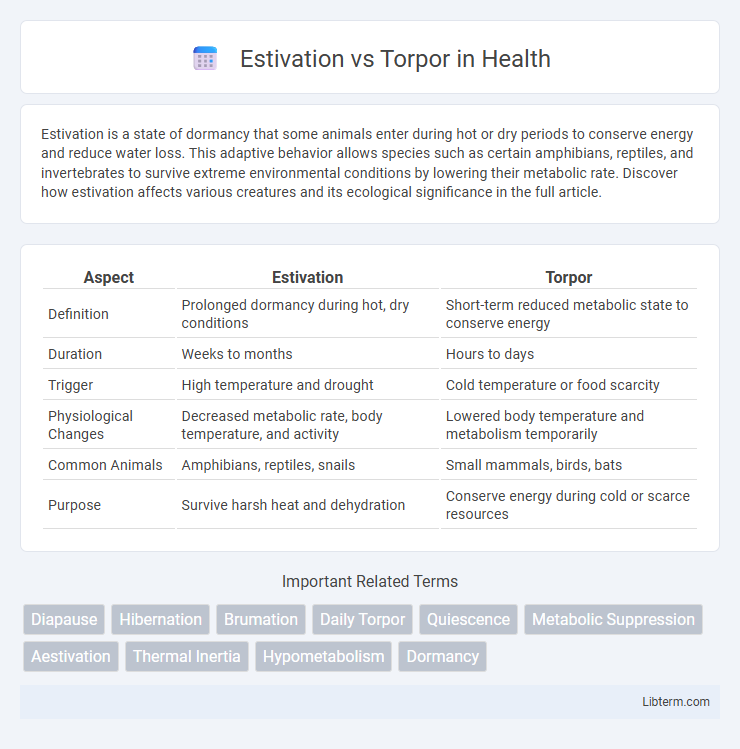Estivation is a state of dormancy that some animals enter during hot or dry periods to conserve energy and reduce water loss. This adaptive behavior allows species such as certain amphibians, reptiles, and invertebrates to survive extreme environmental conditions by lowering their metabolic rate. Discover how estivation affects various creatures and its ecological significance in the full article.
Table of Comparison
| Aspect | Estivation | Torpor |
|---|---|---|
| Definition | Prolonged dormancy during hot, dry conditions | Short-term reduced metabolic state to conserve energy |
| Duration | Weeks to months | Hours to days |
| Trigger | High temperature and drought | Cold temperature or food scarcity |
| Physiological Changes | Decreased metabolic rate, body temperature, and activity | Lowered body temperature and metabolism temporarily |
| Common Animals | Amphibians, reptiles, snails | Small mammals, birds, bats |
| Purpose | Survive harsh heat and dehydration | Conserve energy during cold or scarce resources |
Introduction to Estivation and Torpor
Estivation and torpor are adaptive survival strategies used by animals to withstand extreme environmental conditions, such as high temperatures or limited food availability. Estivation typically occurs during hot and dry periods, allowing animals to reduce metabolic activity and conserve water, while torpor is a short-term state of decreased physiological activity to conserve energy, often triggered by cold temperatures or food scarcity. Both processes involve significant metabolic depression but differ in duration, triggers, and ecological contexts, enabling diverse species to survive harsh climates.
Defining Estivation: Key Characteristics
Estivation is a prolonged state of dormancy that some animals enter during hot and dry conditions to conserve energy and water. Key characteristics of estivation include decreased metabolic rate, reduced body temperature, and inactivity lasting days to months. Unlike torpor, which is typically short-term and occurs in response to cold or food scarcity, estivation specifically helps organisms survive extreme heat and drought.
Understanding Torpor: Main Features
Torpor is a short-term state of decreased physiological activity characterized by reduced body temperature, heart rate, and metabolic rate, enabling animals to conserve energy during unfavorable environmental conditions. It typically occurs daily or intermittently, distinguishing it from prolonged hibernation or estivation. Small mammals, birds, and some reptiles utilize torpor to survive periods of cold or food scarcity by temporarily lowering energy expenditure.
Biological Mechanisms of Estivation
Estivation involves metabolic rate depression, water conservation, and ion channel regulation to survive high temperatures and drought conditions, primarily seen in amphibians, reptiles, and invertebrates. It triggers hormonal changes that suppress non-essential physiological functions, preserving energy and minimizing cellular damage. This state contrasts with torpor, which is a short-term metabolic slowdown mainly used to conserve energy during cold environments.
Physiological Processes in Torpor
Torpor is characterized by a significant reduction in metabolic rate, body temperature, and energy expenditure, allowing animals to survive periods of limited food availability or extreme environmental conditions. During torpor, physiological processes such as heart rate, respiration, and brain activity slow down considerably, enabling the conservation of vital energy reserves. This state differs from estivation, which primarily occurs in response to heat and drought, whereas torpor can occur daily or seasonally in response to cold or food scarcity.
Animals That Utilize Estivation
Animals that utilize estivation, such as lungfish, desert tortoises, and certain amphibians, enter a prolonged state of dormancy to survive extreme heat and drought conditions. Unlike torpor, which is a short-term, daily or seasonal reduction in metabolic rate seen in animals like hummingbirds and bats, estivation lasts for weeks or months to avoid dehydration and high temperatures. This adaptation allows species in arid environments to conserve energy and maintain cellular function when water and food are scarce.
Species Practicing Torpor
Species practicing torpor include small mammals like bats, hummingbirds, and rodents as well as some birds such as swifts and chickadees. Torpor helps these animals conserve energy by significantly lowering their metabolic rate and body temperature during periods of food scarcity or cold weather, allowing them to survive harsh conditions. Unlike estivation, which occurs during hot and dry periods, torpor is primarily a short-term adaptation to cold environments or limited food availability.
Environmental Triggers: Estivation vs Torpor
Estivation is primarily triggered by high temperatures and drought conditions, leading animals to enter a state of dormancy to avoid heat stress and water loss. Torpor occurs in response to cold temperatures and limited food availability, enabling animals to conserve energy by reducing metabolic rate. Both processes serve as adaptive strategies for survival under specific environmental stressors.
Adaptive Advantages of Estivation and Torpor
Estivation provides adaptive advantages by allowing animals to survive extreme heat and drought conditions through metabolic depression and water conservation, which enhances survival in arid environments. Torpor offers energy conservation benefits by reducing metabolic rate and body temperature during periods of food scarcity or cold temperatures, enabling animals to maintain vital functions with minimal resource expenditure. Both strategies improve survival rates by optimizing energy usage in response to environmental stressors.
Key Differences and Similarities Summarized
Estivation and torpor are both adaptive physiological states that animals enter to conserve energy during periods of environmental stress, such as extreme heat or limited food availability. Estivation primarily occurs in response to high temperatures and drought conditions, enabling animals like amphibians and reptiles to survive dehydration, while torpor is characterized by a temporary reduction in metabolic rate and body temperature, commonly seen in mammals and birds during cold conditions or food scarcity. Both states involve metabolic depression and reduced activity, but estivation typically lasts longer and is associated with heat avoidance, whereas torpor is shorter and linked to cold tolerance.
Estivation Infographic

 libterm.com
libterm.com